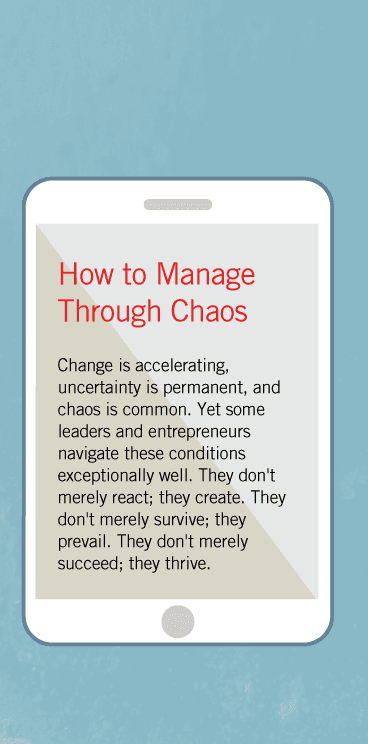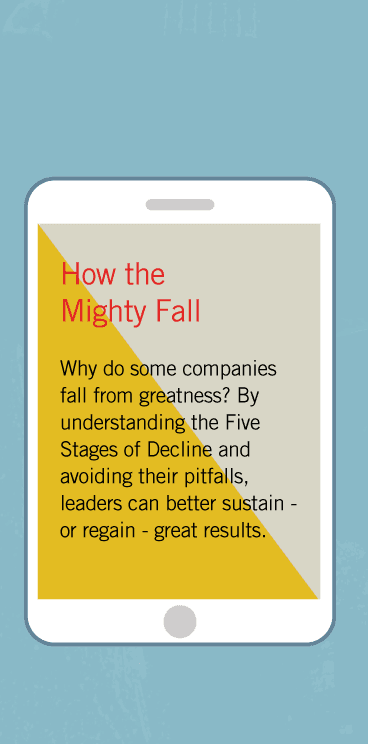The Secret of Enduring Greatness
His argument feels particularly sharp today. Bear Stearns disappeared over a weekend, after more than eight decades of growth to No. 156 on the Fortune 500. Citigroup traces its roots to City Bank of New York, founded the same year Napoleon marched to Moscow, which grew into a visionary global bank under mavericks like Walter Wriston and John Reed. Today Citigroup's CEO reports “unprecedented losses resulting from the sudden and severe deterioration in the U.S. subprime market”—a shock so severe that it overshadowed all of the company's other accomplishments. In 1907 Henry Ford proclaimed, “I will democratize the automobile,” and then made good on his promise. Today Ford Motor Co. fights to create a future for itself in the face of brutal global competition and the green revolution. Fifty–four of the Fortune 500 lost a combined $115 billion in 2007, an amount equal to the entire revenue of more than 20 Fortune 500 companies.
I've been through versions of the creative–destruction argument dozens of times, with smart, well–informed people. And one of their favorite arguments invokes the Fortune 500: If you examine the list over time, you find tremendous churn—the vast majority of those on the list 50 years ago being nowhere to be found on the current list. And, yes, the data do lend credence to the argument:
- Of the 500 companies that appeared on the first list, in 1955, only 71 hold a place on the list today. (The 1955 list included industrial companies only, whereas today's list also includes service companies.)
- Nearly 2,000 companies have appeared on the list since its inception, and most are long gone from it. Just because you make the list once guarantees nothing about your ability to endure.
- Some of the most powerful companies on today's list—businesses like Intel, Microsoft, Apple, Dell, and Google—grew from zero to great upon entirely new technologies, bumping venerable old companies off the list. Robert Noyce invented the integrated circuit in 1958, three years after the first Fortune 500. Dozens of companies on this year's list did not even exist in 1955.
- Some of the most celebrated companies in history no longer even appear on the 500, having fallen from great to good to gone from the list—companies like Scott Paper, Zenith, Rubbermaid, Chrysler, Teledyne, Warner Lambert, and Bethlehem Steel—most often because they capitulated their independence, but sometimes because they outright died.
But if we look through another lens, we can see a different story, a story of well–founded hope. For one thing, we find clear examples of enduring greatness. In 1837, more than two decades before the American Civil War, William Procter and James Gamble formed a partnership to make soap and candles. In 1955, P&G stood at No. 27 on the Fortune 500; today it holds spot No. 23. In 1886, Robert Wood Johnson, operating from the fourth floor of an abandoned wallpaper factory, issued a small catalog jam–packed with antiseptic surgical dressings and medical plasters. By 1955 his son had built Johnson & Johnson into No. 159 on the Fortune 500; today it stands at No. 35, with 45 consecutive years of increasing its dividend. In the early 20th century General Electric's Charles Coffin brought forth perhaps the most significant business innovation of the past 200 years: systematic management development. GE created generations of leaders and thereby generated more than a century of sustained success so reliable that a hiccup in quarterly profits can drive down the entire stock market. In 1955 GE sat at No. 4 on the Fortune 500; today it sits at No. 6. These companies trained leaders who could evolve and create a portfolio of flywheels—from candles to Pringles, from medical plasters to Tylenol, from light bulbs to jet engines—yet they also held tight to core values that have remained fixed for 100 years or more.
We also find companies that overcame oppressive mediocrity or worse to achieve sustained success. In 1965, Nucor Corp., then less than a hundredth the size of Bethlehem Steel, stood on the verge of bankruptcy. With a hodgepodge of unrelated businesses and deteriorating debt ratios, the board made a move of desperation. It turned the company over to a division manager named Ken Iverson, then just 39. “Here,” the board seemed to say, “you're too young to know any better. You take it!” Iverson had run Nucor's only successful division, where he'd built a weird culture of crazed productivity making steel joists. After jettisoning the worst divisions, he began to build ... and build ... and build. He and his team backward–integrated into making raw steel, creating a mini–mill, and discovered that Iverson's culture could be harnessed to produce the lowest–cost steel in America. Step by step, year by year, Iverson and his team added capacity, eventually breaking onto the Fortune 500 at No. 481 in 1980. Today, in the brutally competitive steel industry, Nucor retains a solid No. 151 on the Fortune 500, with 41 years of consecutive profitability. As a testament to the durability of Nucor's culture, the annual report continues a long–held tradition of naming every Nucor employee, more than 18,000 individuals.
We also find companies that fell from greatness, but then regained their footing, standing defiant against the forces of creative destruction. Xerox entered the Fortune 500 at No. 423 in 1963, one of the great success stories in American corporate history, rising to No. 21 by 1990. But then the company began to falter as high costs translated into uncompetitive prices, and by 2001 Xerox had encountered a stock price that plummeted 92% in less than two years, decreasing cash, a falling market position, and an SEC investigation. Some questioned whether Xerox could survive as an independent company. Anne Mulcahy, who did not even make the initial list of CEO candidates, caught the attention of the board with her passion and dedication for the company and its culture. When Mulcahy became Xerox CEO in 2001, after working her entire career deep inside the company, she refused to destroy the company in order to save it. (“I am the culture,” she said. “If I can't figure out how to bring the culture with me, I'm the wrong person for the job.”) Churchillian in her belief that Xerox people could prevail against all odds, she refused to capitulate, refused to sell out, refused to acknowledge the inevitability of defeat. From losses of more than $300 million in 2000–01, she righted the company to more than $1 billion in profits in 2007.
Just because a company stumbles—or just because it gets smacked upside the head by an unexpected event or new challenge—does not mean that a company must continue to decline. Companies do not fall primarily because of what the world does to them or because of how the world changes around them; they fall first and foremost because of what they do to themselves. In the early 1970s Ames Department Stores and Wal–Mart looked like identical twins. They had the exact same business model of rural discount retailing. In fact, Sam Walton copied much of his original model from Ames, and Ames later copied operating ideas from Sam. The only significant difference was that Ames operated in the Northeast, while Wal–Mart moved in concentric circles from Arkansas. Both companies delivered exceptional results, their stock–return charts looking almost like carbon copies of each other from 1972 to 1986, beating the market by more than ten times. But then Ames fell ... and continued to fall into utter irrelevance. Today Ames does not even exist, while Wal–Mart holds the No. 1 spot on the Fortune 500, with $379 billion in revenue. The point: Here we have two companies facing almost identical circumstances with identical trajectories up to a moment in history, yet one falls and the other continues to rise. The root cause simply cannot be attributed to changes in their environment.
Both Ames and Wal–Mart had strong entrepreneurial founders who guided their early growth, but whereas Sam Walton passed the company to a home–grown insider, Ames replaced its entrepreneurial leader with an outsider. Both Ames and Wal–Mart had vast untapped opportunity with their basic strategy of low–price rural discounting, but while Wal–Mart maintained steady organic growth consistent with that strategy, Ames deviated from the strategy in favor of wild growth. In 1988, Ames acquired Zayre, aiming to double the size of the company in a single year. Wal–Mart retained focus on small towns before making an evolution into urban sites; Ames revolutionized itself overnight into urban retailing and catapulted itself into decline. Wal–Mart created its own success, and Ames caused its own death.
It doesn't matter what lens we look through—the lens of those that go from good to great, the lens of zero to great in exciting new industries, or the lens of those that prevail in adversity and last 100 years—one lesson stands out: Whether you prevail or fail, endure or die—whether you make it onto the Fortune 500 and whether you stay there—depends more on what you do to yourself than on what the world does to you.
Teledyne could still have been on the list today—admired, independent, successful—if its extraordinary co–founder, Henry Singleton, had transcended his “genius with 1,000 helpers” style of leadership to build an executive team and culture that could thrive beyond his visionary presence. Bethlehem Steel, which once ranked as high as No. 8 on the 500, could still be on the list if it had confronted the brutal fact that its byzantine class stratification of executives and workers could no longer succeed in the face of mini–mills and low–cost steel. If global competition explains the undoing of Bethlehem Steel, then how does that excuse hold up in the face of the prosperous Nucor and the revitalized U.S. Steel? It doesn't.
Throughout history the greatest companies have used adverse times to their advantage. In the late 1970s, under the farsighted leadership of Dick Cooley and Carl Reichardt, Wells Fargo built a culture of discipline years before deregulation upended the banking industry. They built a team of Spartans: cost–obsessed executives exhilarated by the prospect of fierce competition. When deregulation ripped away the protective cocoon that had enabled mediocre banks to survive, Wells Fargo pounced. It bought Crocker Bank, pulverizing its languid culture into the Spartan ethic, and systematically invaded Bank of America's strongholds in California, trouncing its ill–prepared cross–street rival (which in turn was merged with an upstart regional bank out of North Carolina).
Just because Joseph Schumpeter's creative–destruction argument proves correct for the vast majority of businesses does not mean that the companies that create those businesses must fall and die—after all, you can practice creative destruction inside your own walls and thereby endure for decades, perhaps centuries. Yes, all products, services, markets, and even specific solutions to social problems eventually become obsolete. But that does not mean that the organizations and societies that produce them must themselves become obsolete and irrelevant.
When you've built an institution with values and a purpose beyond just making money—when you've built a culture that makes a distinctive contribution while delivering exceptional results—why would you capitulate to the forces of mediocrity and succumb to irrelevance? And why would you give up on the idea that you can create something that not only lasts but deserves to last? The best corporate leaders never point out the window to blame external conditions; they look in the mirror and say, “We are responsible for our results!” Those who take personal credit for good times but blame external events in bad times simply do not deserve to lead our institutions. No law of nature dictates that a great institution must inevitably fall, at least not within a human lifetime. That most do fall—and we cannot deny this fact—does not mean you have to be one of them.





